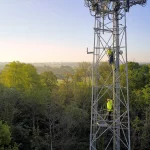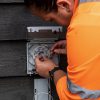OneWeb UK Make Progress on Prototype Broadband Satellite

Space broadband provider OneWeb, which is part-owned by the UK government, has revealed that their recently launched GEN2 prototype satellite – “Joey-Sat” – has passed its initial in-orbit tests and is now moving to start demonstrating what its new technologies will be able to do for faster broadband and 5G connectivity.
Just to recap. OneWeb has already launched 634 of their small (c.150kg) first generation (GEN1) satellites into space – orbiting at an altitude of 1,200km above the Earth (588 of them for coverage and the rest are for redundancy). The network was technically completed in March 2023 (here), but some work (e.g. ground stations) still needs to be completed before global coverage goes live around the end of this year.
The operator also plans to launch another 1,280 satellites in the future (funds allowing), which are expected to reflect a GEN2 model that could sit in a higher Medium Earth Orbit (MEO) of 8,500km. The GEN2s are widely expected to have more data capacity, support for 5G mobile and may, possibly, introduce enhanced navigation and positioning features (something the UK government wants).
Advertisement
As part of that, OneWeb’s last launch in May 2023 included the first £32m prototype of their experimental beam-hopping satellite “Joey-Sat” (here), which is being part funded by both the UK Space Agency (UKSA) and European Space Agency (ESA) via the Sunrise Partnership Project. The prototype is designed to test several key features, such as a digitally regenerative on-board processor from Satixfy (i.e. better performance and latency) and a multi-beam phased array that incorporates beam-steering and beam-hopping antennas.
The advantage of beam-hopping like this is that it will enable the operator to boost coverage in certain locations, such as areas of high usage, where the network may be struggling to cope with demand (e.g. managing real-time surges in commercial demand or responding to emergencies, such as natural disasters). A number of other satellites already have similar technologies, such as Avanti’s HYLAS fleet.
Harshbir Sangha, UKSA Missions and Capabilities Delivery Director, said:
“It is exciting to see OneWeb’s JoeySat pass its initial in-orbit tests so that it can move on to demonstrate the huge potential of its innovative beam-hopping technology to enhance connectivity and improve people’s lives, whether that means better broadband services in remote places, or the ability to respond more effectively to emergency situations.
The UK Space Agency has supported the mission with more than £50 million to fund both the game-changing technology behind JoeySat’s creation and the development of a wider ecosystem that will ensure a reliable and sustainable end-to-end service. We look forward to watching its next-generation capabilities come to life.”
The prototype – built in a single year using off-the-shelf components, new space best practices, and a lean management style – is currently in a near-polar orbit (same altitude and mass as the GEN1s) and will send signals via ground stations in Norway and Sweden to demonstrate the full capabilities of flexible payloads in next-generation constellations with global connectivity. Experiments will include end-to-end communications with dynamic resource allocation, and 5G pilot tests with the University of Surrey in England.
The first non-prototype GEN2 satellites won’t be ready until 2024-25 and are still dependent upon the company being able to raise another £3bn of funding (here).
Advertisement
Mark is a professional technology writer, IT consultant and computer engineer from Dorset (England), he also founded ISPreview in 1999 and enjoys analysing the latest telecoms and broadband developments. Find me on X (Twitter), Mastodon, Facebook, BlueSky, Threads.net and Linkedin.
« Vodafone UK Give Every Mobile a Lifetime Warranty and Battery Refresh






















































The folks at Open Broadcast Encoder have been doing experiments with OneWeb sending back football from Faroe (ISTR). I’m told the experience has been pretty goo. Although the antenna looks larger than their famous competitor’s.
Good, not goo!
probably built with longevity in mind though, as it appears to be a sealed (or at least enclosed) unit with radome instead of the famous competitor’s monument to form over function with all sorts of places that water and dirt can get in.
important for the “connecting remote cell sites” use case where it might be costly and time consuming to get a technician on site.
I believe (and I have no doubt someone will correct me if i’m wrong) that Oneweb had maritime/harsh conditions in mind from the start for their antenna design. Their naval ones look identical so I reckon they just built one tough unit for everything. The competitor antenna wouldn’t last 5 minutes in a maritime environment.